Gomphrena globosa
Globe amaranth is a tropical annual that features long-lasting, globe-shaped blossoms in a variety of colors. Ideal for beds, borders, and rock gardens, plants are drought tolerant and suitable for xeriscapes.
In this guide, we cover all you need to cultivate these unique, colorful flowers in your garden.
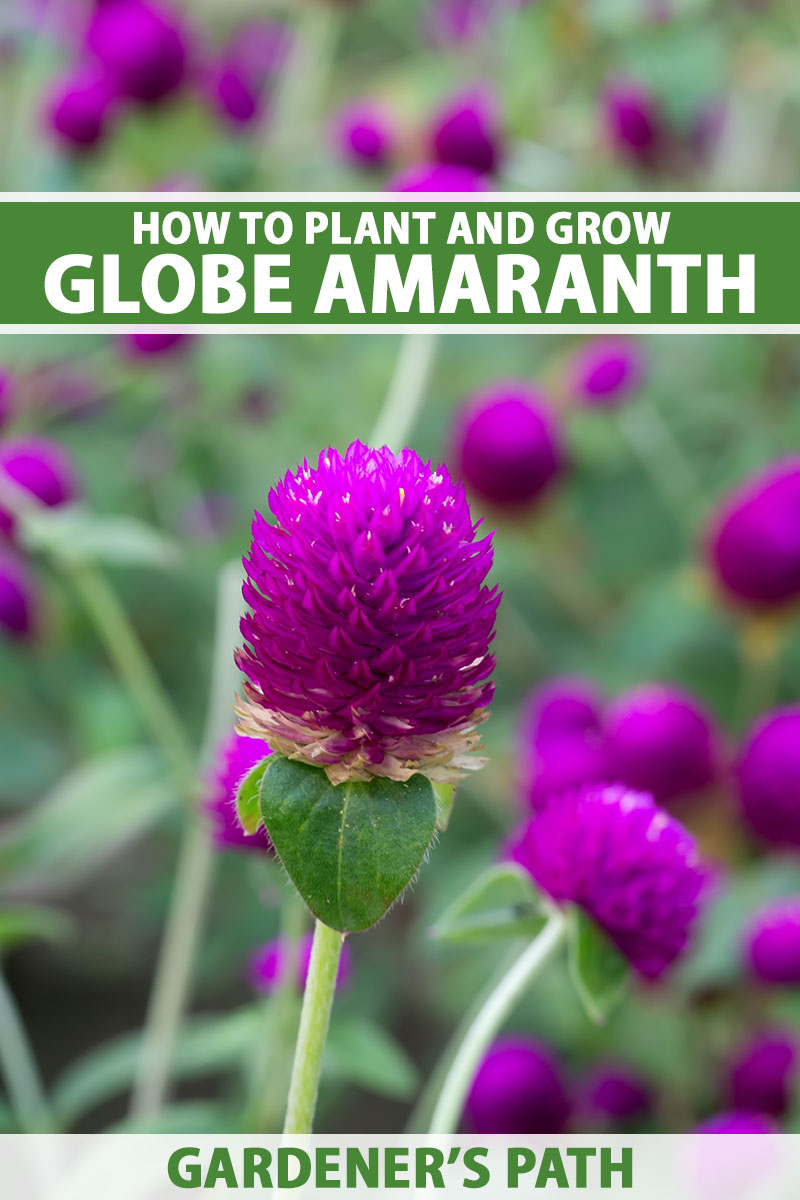
We link to vendors to help you find relevant products. If you buy from one of our links, we may earn a commission.
Globe amaranth, Gomphrena globosa, is one of 90 Gomphrena species of flowering plants in the Amaranthaceae family.
It’s native to Central and northern South America, where its classic magenta blossoms dot the landscape. Related plants include love lies bleeding amaranth, cockscomb, and spinach.
The bright flower heads resemble clover, with tubular bracts instead of petals. They are stiff and papery like those of strawflowers. Each bract contains a tiny white or yellow flower that is visible at close range.
G. globosa is a tender annual in USDA Hardiness Zones 2 through 8, where it blooms continuously from summer through to the first frost.
In Zones 9 to 11 it can grow as an annual and be removed at season’s end, or it may be left in the ground to return as a short-lived perennial.
Self-sowing may produce additional plants, although seeds have a low germination rate.
Thanks to the magic of hybridization, flowers are available in an array of vivid shades, including lilac, magenta, pink, purple, red, orange, and white.
In this article you’ll find all you need to know to grow and care for globe amaranth in your garden.
What You’ll Learn
Let’s get started!
Cultivation and History
Tropical by nature, globe amaranth, aka gomphrena, has a high tolerance for heat and humidity, and craves sunshine.
With its long taproot it has above average drought tolerance, but prefers consistent moisture, especially during the germination and seedling stages.
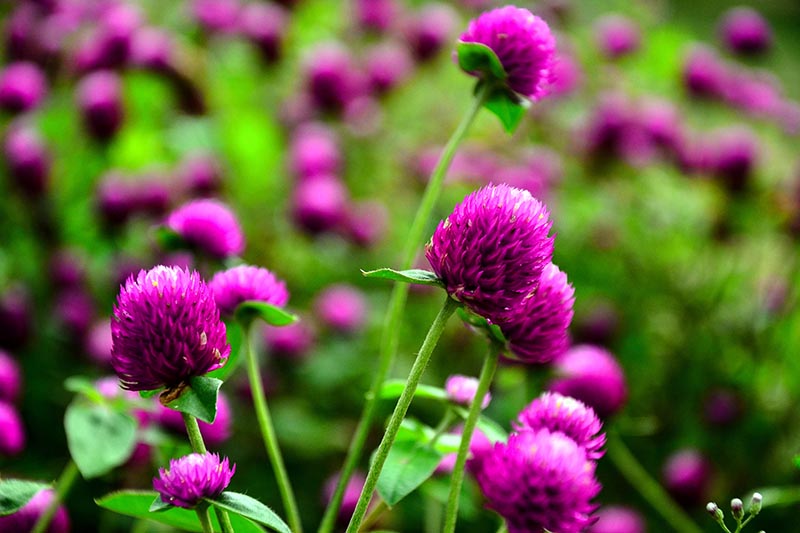
When it comes to soil, it can thrive in anything from loam to clay, provided the drainage is excellent.
This is a plant with an upright growth habit that tends to get leggy unless you pinch some flowers early in the growing season.
There is an array of heights to choose from, as today’s cultivars range from six-inch dwarf varieties to giant four-foot specimens.
And while some may be quite tall, they are compact plants with spreads of eight to 24 inches.
The upright stems exhibit vertical branching. The leaves are hairy and sometimes have slim purple margins. They grow in pairs opposite one another.
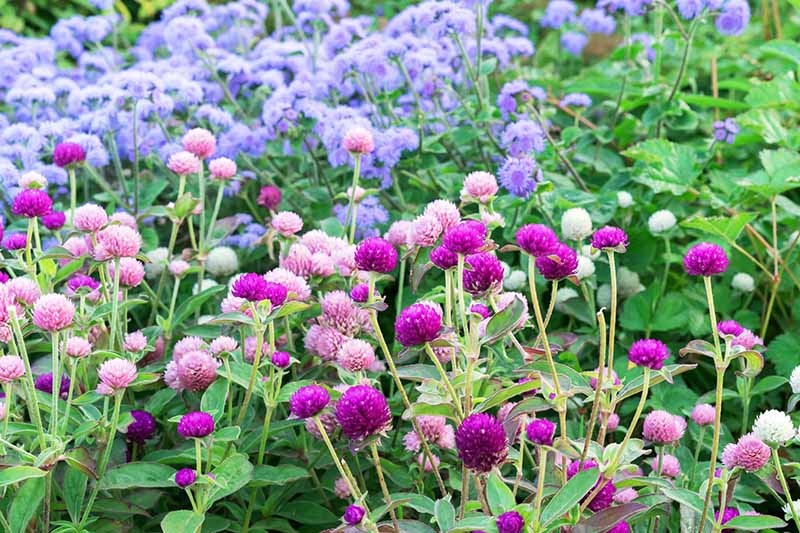
A globe-shaped flower measuring between one and a half to two inches across blooms at the end of each terminal stem.
A fun fact about G. globosa is that it fixes carbon by a C4 pathway.
Huh?
In a nutshell, it’s genetically wired to “breathe” differently than many other plants, so it can conserve energy, retain moisture, and survive in soils lacking in nitrogen that are typical of tropical climes.
The flowers, leaves, roots, and seeds of gomphrena contain immune-boosting phytochemicals and antioxidant betacyanins, and have long been used by herbalists to address an array of ailments ranging from GI to respiratory problems.
The plant arrived in the United States in the 1700s. It was grown as an ornamental in gardens of the well-to-do, and most notably by young Thomas Jefferson, at his childhood home, Shadwell.
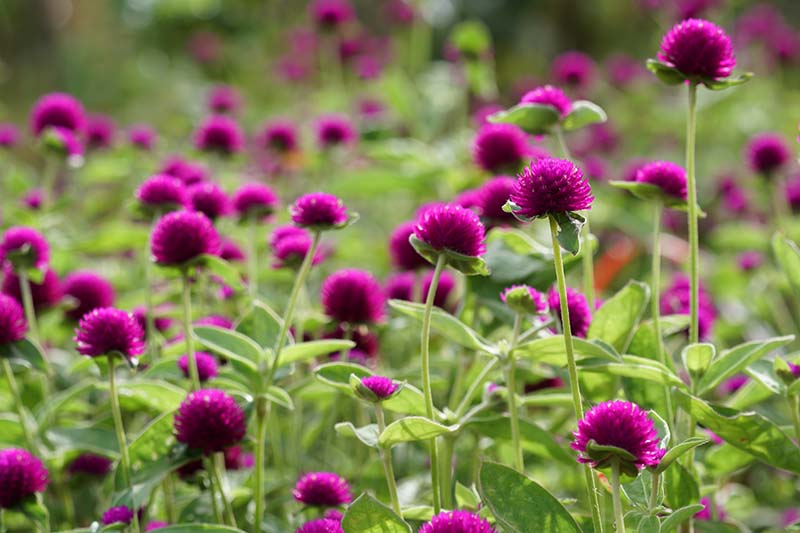
The flowers are a highlight of the gardens at Monticello today.
The blossoms of gomphrena are colorfast, sturdy, and long-lasting. They continue to be featured prominently in traditional ceremonial garlands in Hawaii, where they are called “bozu,” and in Nepal, where they are known as “makhamali ful.”
The species is classified as invasive in Costa Rica, Cuba, and Hawaii.
Propagation
Plants may be grown from seeds. Germination is slow, and can take from two to four weeks.
In addition, the rate of germination tends to be low, which means a large proportion of seeds may fail to sprout. Maturity takes anywhere from 85 to 100 days.

This species has a deep taproot that should be disturbed as little as possible.
For both perennial and annual cultivation, soak seeds overnight and start seeds indoors eight weeks before the last average spring frost date to get a jump on the growing season.
Use biodegradable seed starter cells or cardboard egg cartons that can be separated for planting. The seeds are tiny, so do your best to sprinkle only about four of them into each cell.
Cover them lightly with one-eighth of an inch of potting medium.
Thin the seedlings to one per cell when they have one to two sets of true leaves.
After the danger of frost has passed, acclimate the seedlings to the outdoors by setting them outside for a few hours each day for three to five days prior to planting them out.
Transplant the individual cells directly into the garden or deep containers after the danger of frost has passed.
For perennial growing, you can also direct sow seeds in the garden, but they may not mature and bloom until the second year.
How to Grow
To cultivate this plant in your garden, wait until the last average frost date for spring has passed before transplanting seedlings. Those who may direct sow have no frost worries in Zones 9 to 11.
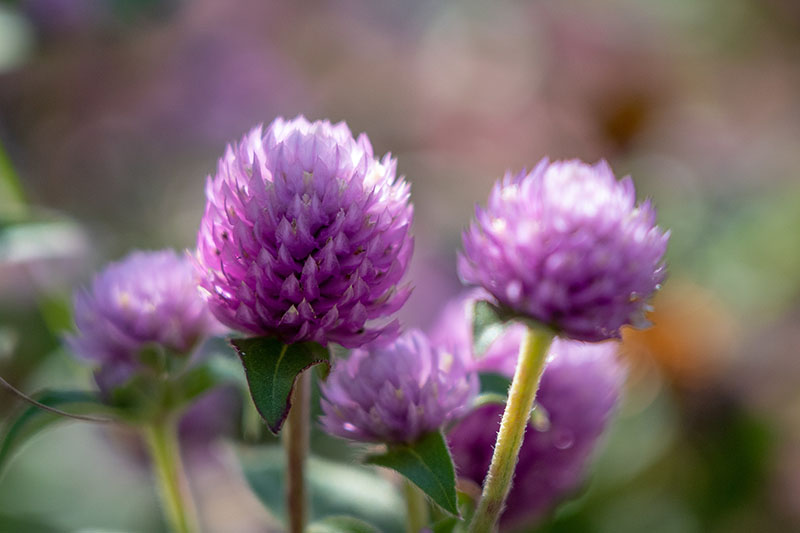
Choose a location in full sun. The soil can range in quality from organically-rich loam to clay, provided it drains exceptionally well.
Ideally, the pH is in the range of 6.1 to 7.5, or slightly acidic to the barest hint of alkalinity.
To learn about the characteristics of the earth on your property, conduct a soil test through your local agricultural extension service. Adding compost is one way to increase acidity, while mixing in lime reduces it.
Given globe amaranth’s long taproot, you’ll need to work your garden soil to a crumbly consistency to a depth of at least 12 inches. Add amendments as needed.
Keep the long taproot in mind when container gardening. The taller the plant, the deeper the pot needs to be. Depths of 12 to 24 inches should be adequate.
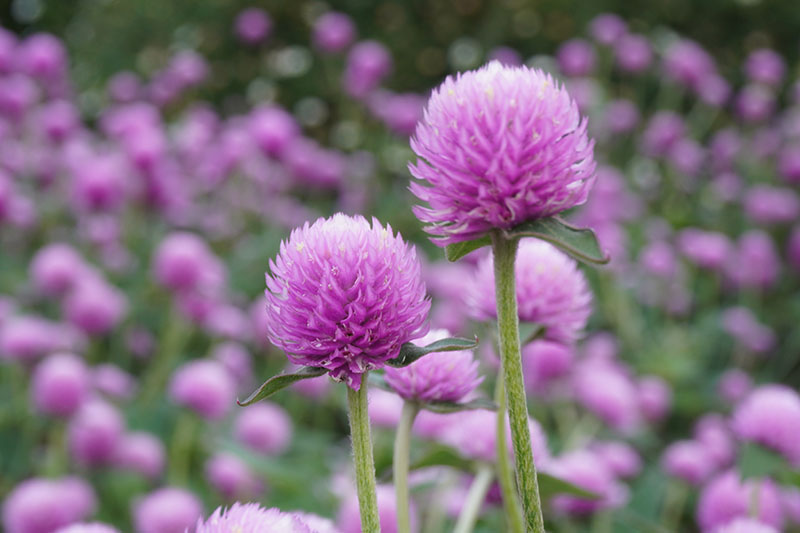
Sow seeds one-eighth of an inch deep. Scatter a few every four to six inches and cover them lightly with soil.
To transplant thinned out seedlings, cut egg cartons apart if necessary, and bury individual cells or biodegradable containers in their entirety at the same depth as the soil in the cells.
It’s not necessary to fertilize. However, if you routinely treat your garden plants to a nourishing dose, make sure to choose one that’s low in nitrogen, or you may find that you get lots of leaves and few flowers.
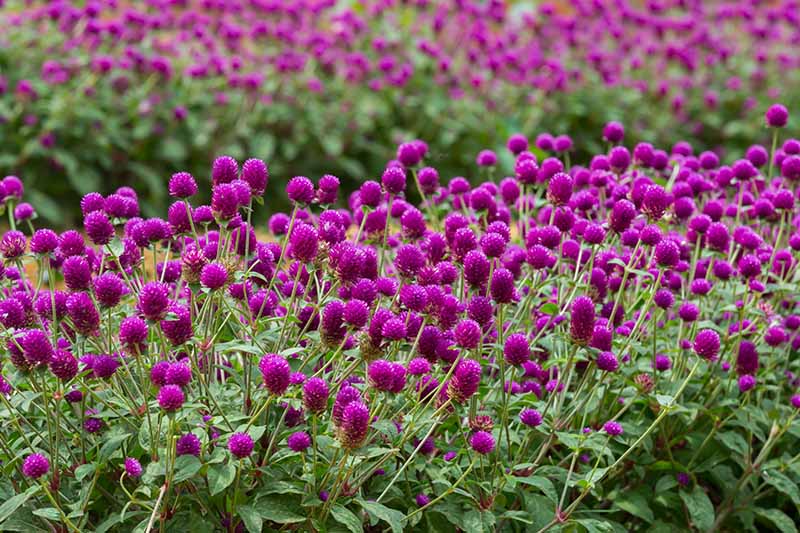
Maintain even moisture, but don’t overdo it. Oversaturation can make sprouts prone to “damping off,” a fungal disease that causes them to flop over and die.
When the seedlings have one to two sets of true leaves, thin them out to a spacing of 12 to 18 inches. Good airflow also aids in inhibiting fungal disease.
As plants mature, provide no more than one inch of water per week through a combination of rain and supplemental watering.
Always aim the hose or watering can at the soil, not the leaves, to inhibit fungal growth.
When you see the first flower buds forming, you can pinch them off to encourage bushier growth. Leggy plants may require staking.
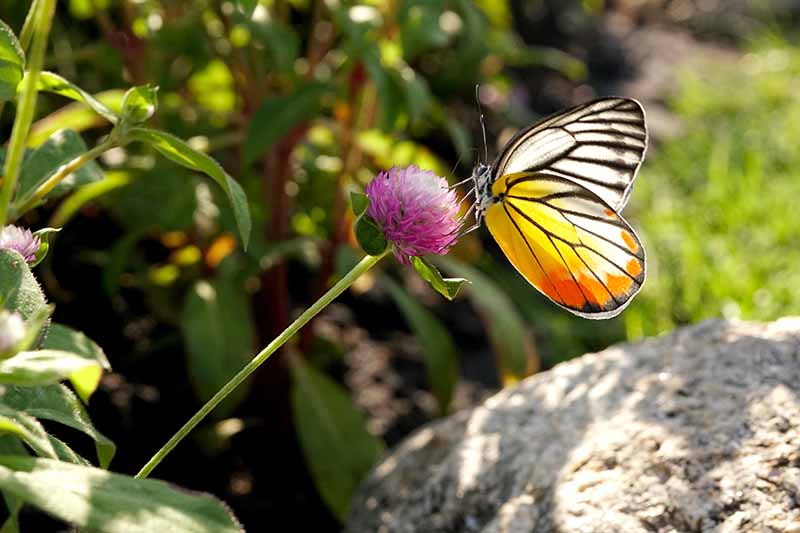
Throughout the growing season, periodically deadheading or cutting flowers for arranging serves not only to inhibit leggy growth, but to encourage further blooming.
For best results, cut a portion of a stem, not just a flower head, at a point where it meets another stem, or where two leaves meet.
As a tropical plant, gomphrena loves heat, but requires moisture. And while it withstands drought better than some plants, it thrives best under conditions that mimic the tropics.
Growing Tips
Now that you’re all set to grow your own plants, let’s recap some key points before we continue:
- Seeds are slow to germinate; sow extra and thin later.
- This is a tropical plant, not a desert one, so while it loves heat, it needs consistent moisture.
- Fertilizer isn’t necessary and may lead to an overproduction of leaves.
- Respect the deep taproot with little disturbance and deep containers.
Cultivars to Select
Choosing cultivated varieties of G. globosa is fun because there are so many colors and sizes available.
Here are a few to ponder:
Audray White
‘Audray White’ boasts crisp white blooms atop 18-inch stems.
This mid-size variety is well-suited to middle placements in beds and borders, as well as containers.

Its neutral tone makes it a great buffer between plants of different shades and a visually appealing companion to all.
Find packets of 50 seeds from David’s Garden Seeds Store via Amazon.
Fireworks
If you’re looking to impress, giant ‘Fireworks’ tops out at 36 to 48 inches and may just be the one you’re looking for.
With hot pink bracts and tiny, but highly visible yellow flowers, this is your choice for a specimen planting to capture the attention of passersby.
You can find a set of four starter plants or a packet of 30 seeds available at Burpee.
Mixed Gnome
This grab bag of pink, purple, and white mixed ‘Gnome’ flowers bloom on low-profile plants that top out at a petite six inches.
Perfect for small containers and fronts of borders, these cotton candy sweethearts are sure to please.
Find mixed ‘Gnome’ seeds in packets of 1,000 available from True Leaf Market.
Managing Pests and Disease
G. globosa is not especially prone to pests and disease, and with best gardening practices you should have few to none.
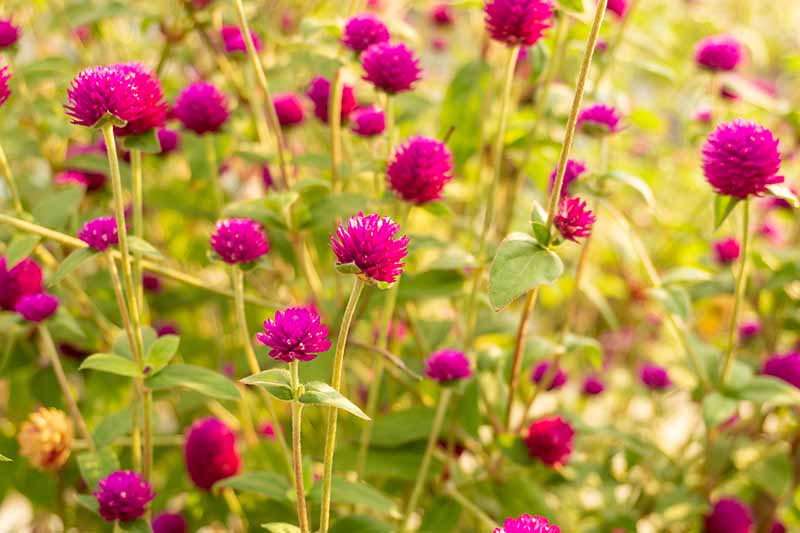
However, there are several sap-sucking insects that not only destroy foliage with their voracious eating habits, they can also be carriers of disease.
Two pests to watch out for are:
If you can’t get rid of them with a firm spray from the garden hose, an application of organic neem oil should do the trick.
As for disease, the following conditions may present themselves when conditions are less than ideal:
- Alternaria Leaf Spot
- Botrytis Blight, aka Gray Mold
- Damping Off
- Powdery Mildew
Alternaria leaf spot causes dead brown patches ringed in yellow on mature leaves. Unchecked, entire leaves curl and brown before dying and dropping. Discard affected leaves in the trash and apply a fungicide.
Botrytis blight and powdery mildew are fungal diseases that damage foliage by infecting them with grayish, fuzzy mold.
Treat both by picking off and disposing of affected material in the trash and applying a fungicide.
Damping off, as discussed in the growing section, is a fungal disease that can hit oversaturated sprouts and cause them to literally keel over and die. It is incurable.
To avoid infestation and infection be sure to:
- Plant in full sun, not only for beautiful, sun-loving blooms, but to keep foliage from staying wet and inviting fungal growth.
- Follow spacing recommendations when planting. Good airflow inhibits moisture buildup and fungal conditions.
- Weed the garden regularly to deter pests from making your garden their home.
- Water at the soil level to keep from oversaturating foliage and making it fungus-prone.
- Don’t overwater. Maintain moisture, but don’t oversaturate, especially at the seedling stage.
When you grow gomphrena as an ornamental specimen, foliage affected by pests and/or disease is not pretty, but when you catch it and treat it, the flowers may be just fine.
If you are cultivating plants as edibles, you will need to be extremely vigilant when it comes to not consuming infested or infected material, as well as using only treatment products that are intended for use on edibles.
And on that note, it’s time to talk about picking and using flowers, leaves, seeds, and even roots for ornamental purposes or consumption.
But before we do, let me recommend proceeding with caution when consuming a plant just because it is edible. All foods don’t agree with all people, so if you have allergies or other health conditions, please consult your medical practitioner for guidance before experimenting.
Harvesting and Preserving
Globe amaranth is generally grown as an ornamental plant; however, as the tender sprouts, young leaves, flowers, roots, and seeds are edible, they are all fair game for harvest, if you’re so inclined.
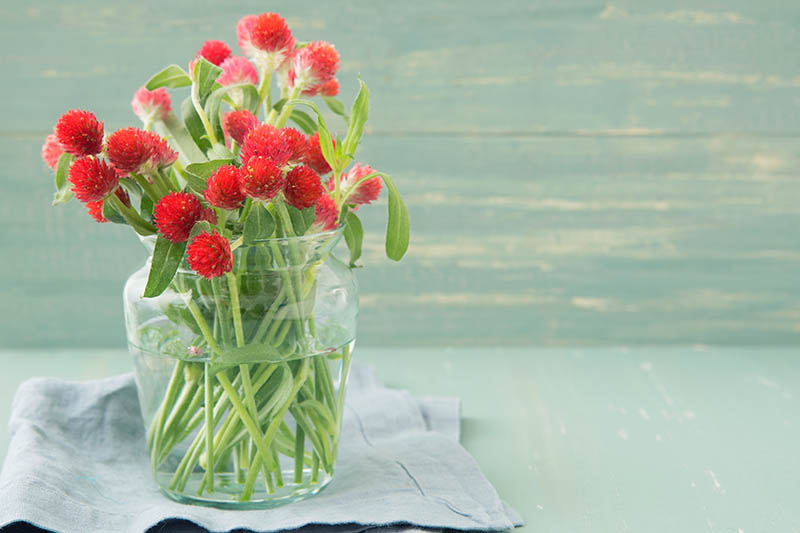
In addition, the intense color of the traditional magenta blossom makes a lovely natural food dye.
You can pick the sprouts to eat as microgreens, and the tender young leaves before they get fuzzy and tough.
Harvest flower heads as desired by pinching them off at the base of their stems, where they meet another stem or pair of leaves. Choose those that are almost, but not quite, fully open.
At the end of the growing season, you can harvest both roots and seeds.
To harvest the roots, dig the plant up when it has finished blooming, and before the first frost.
Cut the stems off at the crown.
Rinse the soil off the roots before use.
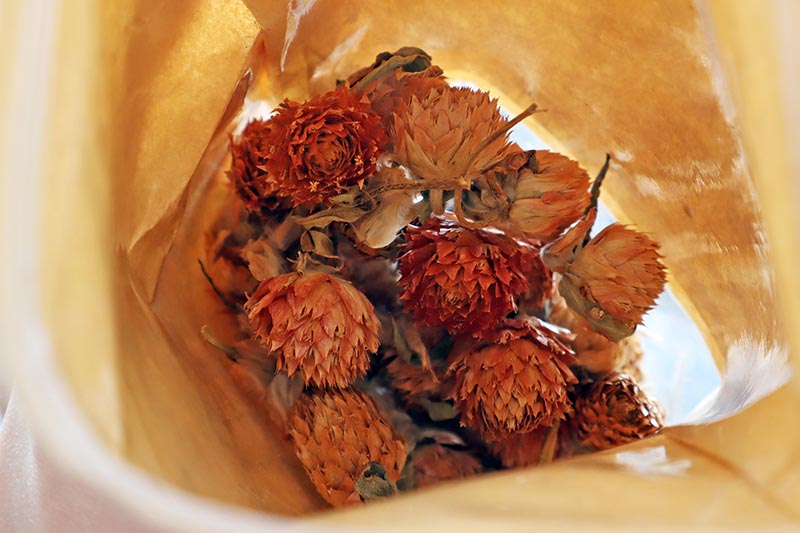
To harvest the seeds, wait until the flower heads are dry and tan in color. Snip them off and pull them apart over a light colored cloth for better visibility, releasing them and separating them from the chaff as you go.
If you are gathering them to sow next year, please note that the seeds from hybrid plants are not always viable, and when they are, are likely to produce surprising traits that don’t necessarily resemble those of parent plants.
Tender sprouts and young leaves should be consumed as soon as possible after picking, so toss them onto your lunchtime salad, or into a simmering stew for the dinner crowd.
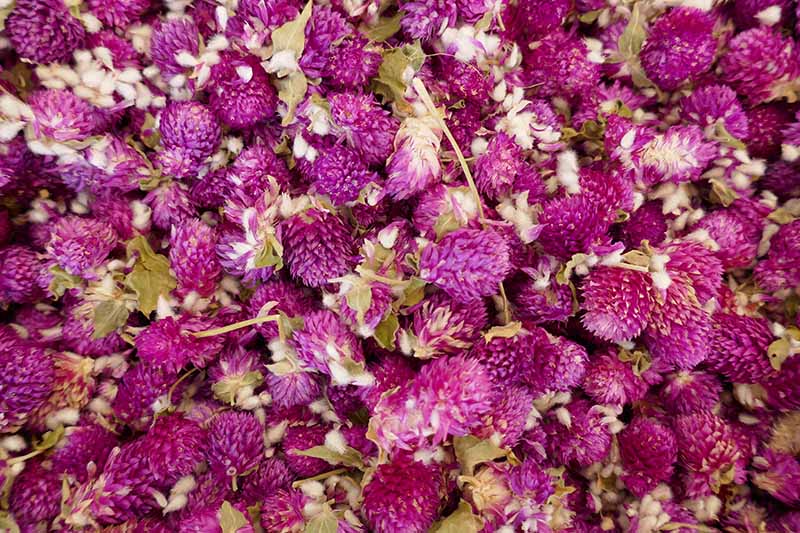
Fresh flowers should also be used right away. They make pretty garnishes or an earthy tea when brewed.
To dry flowering stems at their peak of color:
Cut the stems as soon as the flowers fully open. Include those in the bud or half-open stage, if you like. Avoid flowers that are beginning to lose their color and run to seed.
Whether you remove or leave the foliage attached is entirely up to you.
Gather the stems like a bouquet.
Bind them with twine, leaving long ends for suspending them from a hook or nail.
Hang them up upside down, and allow them to dry for three to four weeks. The stems and leaves will turn brown, but the flowers will retain their vibrant hues.
Use full stems in floral arrangements, and snip some flower heads off to add color to potpourri sachets, brew into tea, or to make natural dye.
Dry flower heads should keep for a year in an airtight jar. As with seeds, if they appear to spoil, discard them.
Edible roots are generally consumed as other root vegetables, like carrots. Depending upon their thickness, they may last a few days in the fridge before becoming limp and unappealing.
Dry seeds should keep well for a year in an airtight jar. If discoloration, mold, or odor occur, discard them.
Best Ornamental Uses
Available in sizes ranging from six-inch dwarf varieties to four-foot giants, the compact nature and continuous bloom of G. globosa make it perfect for beds, borders, pots, rock gardens, xeriscapes, and window boxes that get full sun.
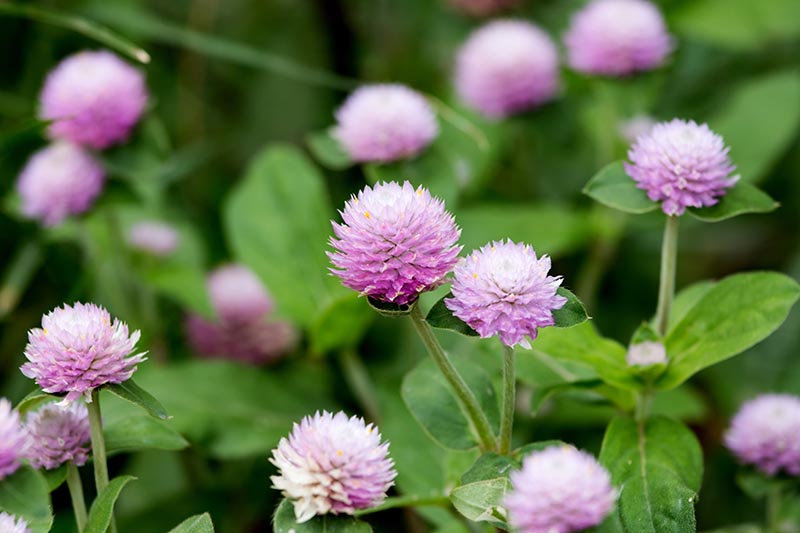
In addition, the taller varieties make great cutting flowers for summer and fall centerpieces, and all sizes dry beautifully for use in wreaths and everlasting arrangements.
If you’re growing in containers, be sure they have adequate drainage holes before filling with potting soil.
Wherever you find them a home, these sturdy, bold blooms are sure to pop with color. Try pairing them with these plants that share similar cultural requirements:
With G. globosa in the garden, you’re sure to attract bees, butterflies, and other beneficial pollinators to all the plants that grow there.
Quick Reference Growing Guide
| Plant Type: | Tender flowering annual, short-lived perennial | Flower / Foliage Color: | Lilac, magenta, pink, purple, red, orange, white/green |
| Native to: | Central and northern South America | Maintenance: | Low |
| Hardiness (USDA Zone): | 2-11 | Tolerance: | Deer, drought, poor soil |
| Bloom Time: | Summer-frost | Soil Type: | Average |
| Exposure: | Full sun | Soil pH: | 6.1-7.5 |
| Spacing: | 12-18 inches | Soil Drainage: | Well-draining |
| Planting Depth: | 1/8 inch | Attracts: | Bees, butterflies, and other pollinators |
| Height: | 6-48 inches | Companion Planting: | Celosia, marigold, Mexican petunia, salvia, zinnia |
| Spread: | 8-24 inches | Uses: | Beds, borders, containers, cutting, drying, rockeries, xeriscapes |
| Growth Rate: | Slow | Family: | Amaranthaceae |
| Water Needs: | Medium | Genus: | Gomphrena |
| Common Pests and Disease: | Aphids, thrips; Botrytis blight, Cercospora leaf spot, damping off, gray mold, powdery mildew | Species: | Globosa |
Robust and Everlasting
Here in the Northeast, for my money, G. globosa is a great investment in an annual plant because it infuses my summer-to-frost gardens with richly saturated color and texture.
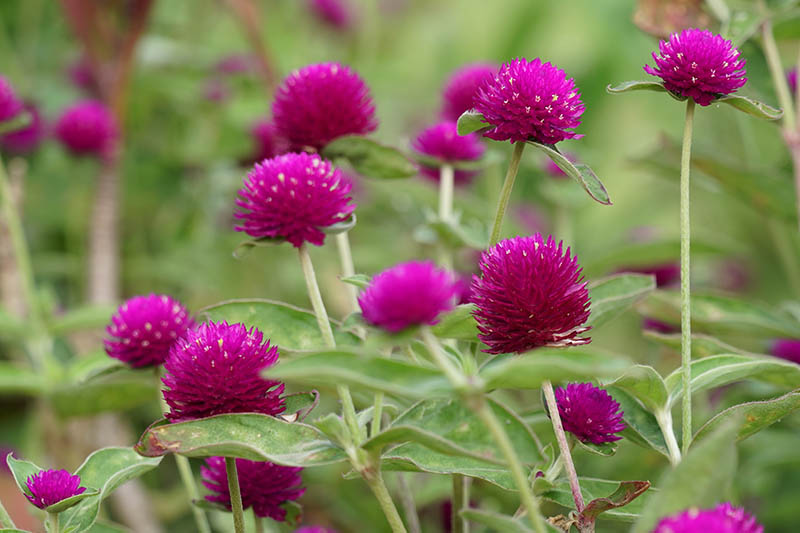
And, I especially enjoy arranging flowers and foliage from the backyard that don’t just look great fresh, but retain their vibrant color even when dried.
It’s time to take out your garden planner and decide where you’re going to plant globe amaranth. Whether as an ornamental or edible, it’s sure to pep up existing spaces with its multitudes of cheery blooms.
Have you had success with globe amaranth at your house? Tell us about your experience with this continuously flowering annual in the comments section below.
And for more information on growing flowers in your garden, check out these guides next:
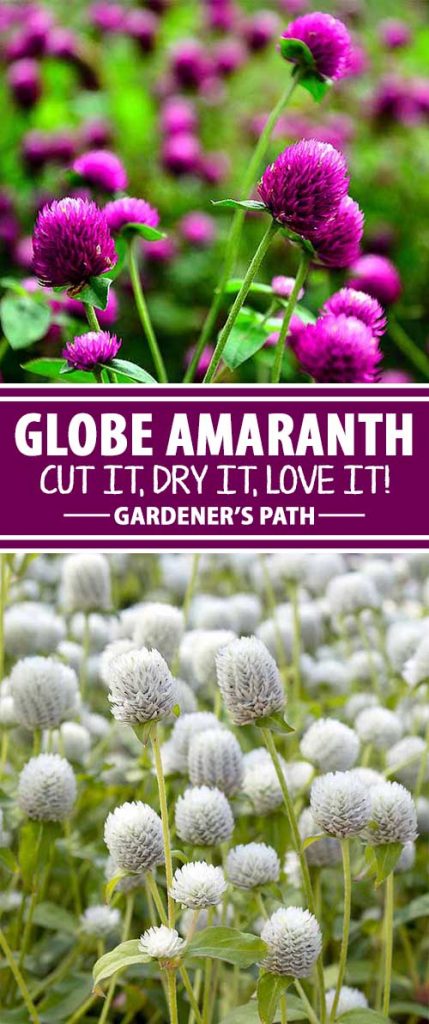
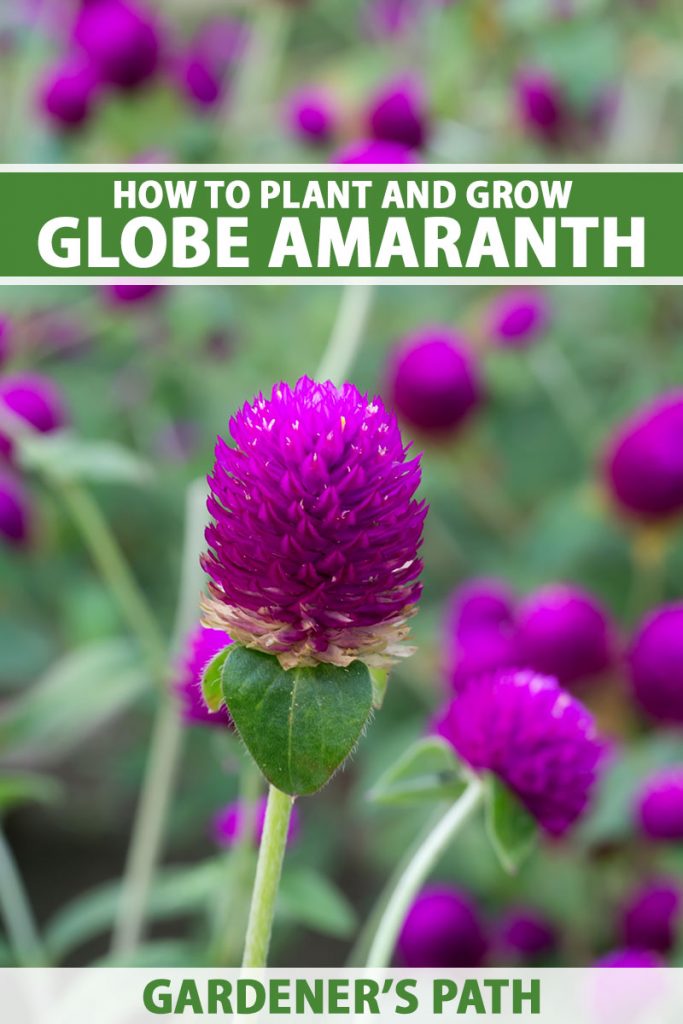


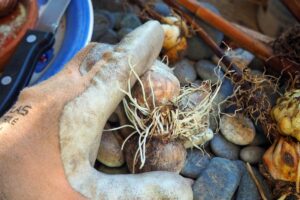
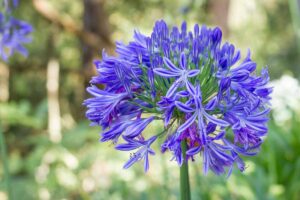
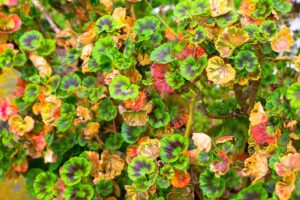
Such a thorough and well-written article!
Hello Rick –
Thank you so much and welcome to Gardener’s Path.
I dug my 2 plants up and planted in containers for winter. I put them in front of a sunny window and deadheaded all the blossoms. So far so good!
Hi Ciney –
Globe amaranth grows as an annual in USDA hardiness zones 2 to 11. Growers in zones 9 to 11 have the option of leaving the plants in the ground to grow as short-lived perennials that will return annually for three to five years.
It is possible to overwinter a short-lived perennial in a pot, provided you cut the stems back to just above the soil surface and water sparingly once or twice during the winter months. It is not necessary to provide light during winter dormancy.
Thank you for such a great, detailed article!
For me in zone 4B Ontario I usually have trouble getting gomphrena to even germinate and I’m going to try again this year on a heat Mat indoors… fingers crossed… I research most seeds before hand, and I think yours was the only article that talked about the taproot, which makes a big difference for transplant time, and may have been one of my failings!
Hi HMH –
You’re welcome. We’re happy you found the article informative and wish you the best of luck with your globe amaranth.